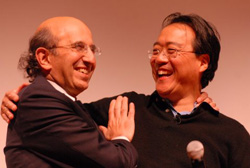Filed Under > NYC Schools
Yo-Yo Ma Performs at TC
Renowned Cellist's Organization Launches Two-year Collaboration with NYC Schools That Will Focus on Middle School Students
The renowned cellist Yo-Yo Ma has recorded more than 75 albums and won an astounding 15 Grammy awards, but at Teachers College on Wednesday, February 25, he was—first and foremost—a fan of public school teachers and what they do.
“I think the work that you do is the most important in the world—and not only that, it’s probably also the hardest,” Ma told the many New York City public school educators who joined TC students, faculty and staff in the audience at the Cowin Center. “My work is easy, but there are few things we share in common… First, I don’t know of any teacher or performer who doesn’t want to make their work memorable. The second thing is that we share a passionate commitment to making a difference in someone else’s life.”
Ma’s presentation and performance—he played Bach’s Suite No. 1 for Cello—was part of the kickoff of the Silk Road Curriculum and Student Engagement Project, a two-year educational initiative with the New York City public schools developed by Ma’s nonprofit organization, the Silk Road Project, in conjunction with the Stanford Program on International and Cross-Cultural Education (SPICE). The project will also include a curriculum developed by TC, the Manhattan School of Music, the American Museum
Prior to Ma’s appearance at the Cowin Center, 150 sixth-grade teachers in the New York City schools took part in a two-hour training session on the SPICE curriculum, known as Along the Silk Road. The curriculum involves lessons on everything from history and geography to science and music as they relate to the Silk Road, the historic trading route that connected China to the Mediterranean .
Hundreds of teachers in the Chicago Public Schools have been teaching Along the Silk Road since the fall. In New York City
“I am so excited about what is going on here,” Klein said. “Yo-Yo asked me, ‘Can we do here what we did in Chicago New York Chicago Chicago
Ma established the Silk Road Project, which is affiliated with the Rhode Island School of Design and Harvard University
In recent years, however, the Silk Road Project has produced a series of educational materials for teachers. Silk Road Project Chief Executive Officer Laure Fried said the organization has already begun working with TC, the New York City Department of Education, the Manhattan School of Music, and the American Museum
Indigo refers to the dye, extracted from plants, that produces the color blue, and was traded widely along the Silk Road . Developed in India
After he performed the Bach sarabande, Ma told the audience that his cello was every bit as interconnected as the Silk Road and indigo dye, for it was made in Venice in 1733 with the ebony for the neck from Africa, varnish from Acacia trees in the Middle East, and the yellow tinting in the wood from curry powder in India.
“So here we have a cello and bow and music that come from a lot of different places,” Ma said. “One of the things we learned in the Silk Road Project over the last several years is that the more deeply you go into something, the more you find the connections to the rest of the world.”
Published Friday, Feb. 27, 2009

